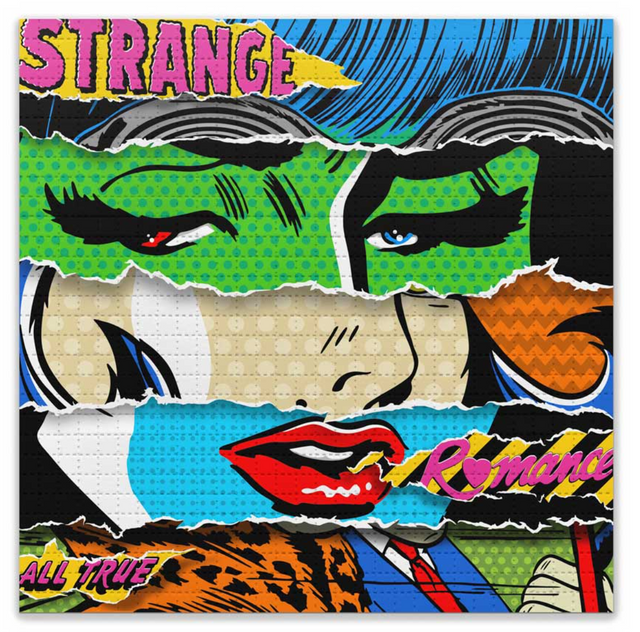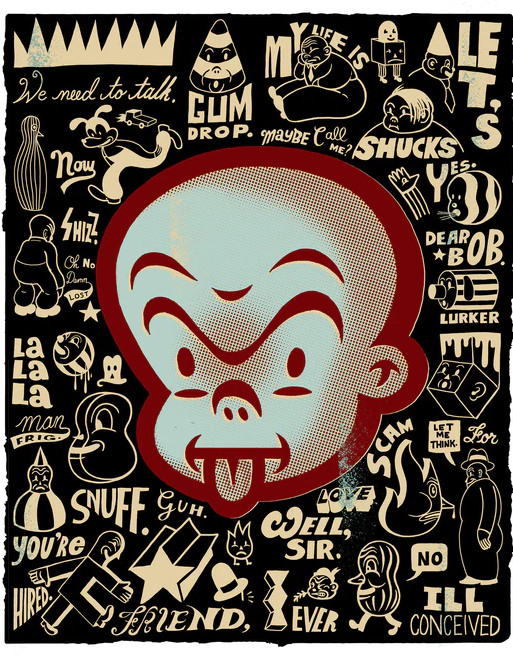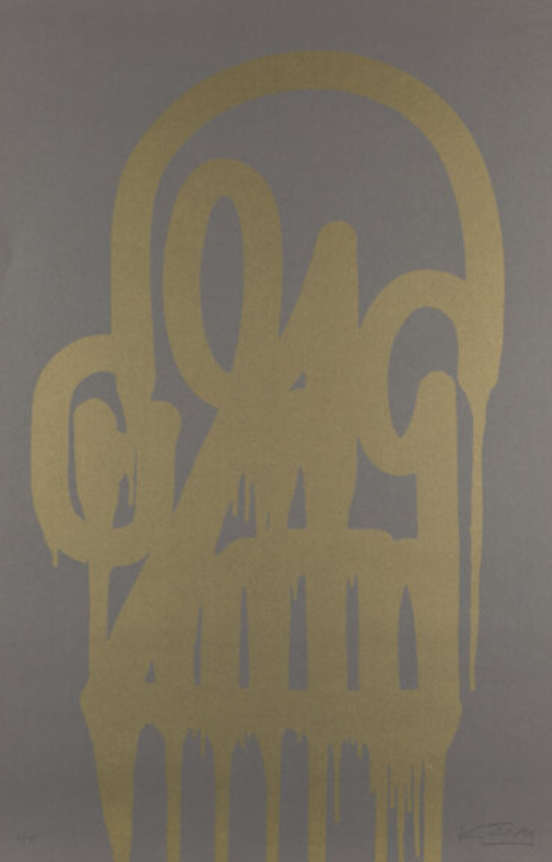
Face & Head
-

Gary Taxali We Need To Talk Silkscreen Print by Gary Taxali
We Need To Talk Silkscreen Print by Gary Taxali Hand-Pulled 5-Color on Cover White Arches Fine Art Paper Limited Edition Artwork. 2015 Signed & Numbered Limited Edition of 50 Artwork Size 25x31 Silkscreen Print Decoding Gary Taxali's "We Need To Talk" Silkscreen Print Gary Taxali's "We Need To Talk" is a silkscreen print encapsulating the essence of Street Pop Art and Graffiti Artwork. Released as a limited edition in 2015, this print demonstrates Taxali's distinctive art style that merges the old with the new, the classic with the contemporary. The artwork is a substantial 25x31 inches, making it a statement piece for any collector. This hand-pulled 5-color print on Cover White Arches fine art paper is a testament to Taxali's craftsmanship and attention to the finer details of printmaking. The choice of Arches paper, known for its texture and durability, speaks to the quality and longevity of the print. Each piece in the limited edition of 50 is signed and numbered by Taxali, highlighting the exclusivity and authenticity of the work. "We Need To Talk" features a central monkey-like figure surrounded by graphic elements and text, all interplaying to create a narrative open to interpretation. The monkey's direct gaze and the surrounding dialogue bubbles and text snippets such as "GUM DROP," "SHUCKS," and "DEAR BOB" suggest a conversation that is both playful and poignant. The use of bold colors and sharp contrasts, along with Taxali's signature illustrative style, creates a visual language that draws the viewer in and encourages them to explore the deeper meanings behind the art. Taxali's work is often reflective of societal commentary and personal expression. In "We Need To Talk," one could argue that the juxtaposition of text and image invites the viewer to consider the complexities of communication in the modern age. The phrases interspersed throughout the artwork resonate with the cacophony of messages and information that bombard us daily. At the same time, the central figure's emotive expression serves as a focal point amidst the noise. Taxali's print stands out for its engagement with the viewer in the broader context of Street Pop Art and Graffiti Artwork. Street art is known for its public accessibility and often aggressive nature. While Taxali's work is housed within the more private confines of a gallery or collection, it retains the spirit of street art through its bold messaging and visual impact. Given its limited-edition nature, the artwork is a visual treat and a collector's item. Numbering and signing each print creates a direct connection between the artist and the collector, a hallmark of acceptable art practices. Taxali's integration of high art techniques with street art's approachability exemplifies these art forms' evolving nature and increasing overlap. "We Need To Talk" by Gary Taxali is a powerful piece of art that combines the artist's unique visual style with the interactive and message-driven qualities of Street Pop Art and Graffiti Artwork. This print is a reflection of Taxali's skill as an artist and his ability to communicate complex themes through the medium of silkscreen printing. For collectors and admirers of contemporary art, this work is not just an aesthetic addition but a conversation starter, a narrative piece that invites interpretation and contemplation. As Taxali continues to influence the art world, works like "We Need To Talk" are significant milestones in his artistic journey, capturing the zeitgeist of our times through the lens of pop and street art.
$676.00
-

Katsu Timeless Skull Metallic Gold Shadow Metallic Silkscreen Print by Katsu
Timeless Skull Metallic- Gold Shadow Limited Edition Gold Metallic Ink on Shadow Metallic Paper by Katsu Graffiti Street Artist Modern Pop Art. 2015 Signed & Numbered Limited Edition of 75 Katsu Artwork Size 25x39. I was scuffing On the Lower and middle Of the Paper. "Skulls are the universal image for rebellion; Pirate flags use them as the ultimate offense, cannibals decorate their camps with them, and the skull represents how I live my life. The single-stroke skull came out of my desire to tag faster. As a young tagger, I became fascinated with the practicality of tagging different designs and shapes. I wanted to engineer an attractive design from an artistic standpoint and from the idea of efficiency. The skull is how I condemn surfaces, structures, how I condemn the public space." - KATSU Katsu's Affinity for the Skull Motif Skulls have long been a symbol of rebellion and nonconformity in various subcultures, and in the realm of street art, they hold a particularly potent significance. The skull is not just a morbid fascination but a statement, a form of resistance, and for the street artist Katsu, it is a canvas of condemnation and a mark of efficiency. This piece delves into the significance of Katsu's limited edition gold metallic ink on shadow metallic paper artwork and its place in contemporary street art. Katsu's little edition work, a striking fusion of gold metallic ink on shadow metallic paper, presents a skull in a visually arresting and thematically rich way. With only 75 pieces created, the exclusivity of the artwork amplifies its impact on modern pop art. Katsu's approach to the skull is deeply rooted in his identity as a street artist. He recognizes the skull as a universal emblem of defiance, reminiscent of pirate flags and tribal decorations. His interpretation, however, is unique in its simplicity and speed. The single-stroke skull that characterizes Katsu's work emerged from a youthful fascination with the efficiency of tagging. This desire to create swiftly without sacrificing aesthetic appeal has led to a minimalist yet powerful representation of the skull. The Impact of Katsu's Work on Public Spaces Katsu sees his skulls as more than just art; they are a statement against the structures and surfaces they adorn. By placing his work in public spaces, Katsu engages in a dialogue with the viewer, often without their consent. This act of 'condemning' public spaces is a form of social commentary and a challenge to the norms that govern our visual landscape. In doing so, Katsu aligns with the core tenets of street art: accessibility, anonymity, and transience. His skulls are not meant to be preserved in galleries but experienced in the wild, where they can confront and provoke thought. The technical aspects of Katsu's work are as fascinating as the ideological. Using gold metallic ink on shadow metallic paper is a deliberate choice that plays with light and perspective. The reflective quality of the gold ink catches the viewer's eye, while the shadowy backdrop adds depth, making the skull appear to emerge from the darkness. The contrast symbolizes the interplay between life and death, presence and absence. Katsu's limited edition pieces are a testament to his mastery of materials and ability to imbue a static image with a sense of life and motion. Katsu's Legacy and Influence on Modern Pop Art Katsu's skulls are more than a personal signature; they are a part of the larger narrative of street art's evolution. By adopting a symbol with history and giving it a modern twist, Katsu positions himself within a lineage of artists who use the urban landscape as their canvas. His work bridges graffiti's raw, gritty beginnings and the polished, thought-provoking installations of contemporary street art. As such, Katsu's skulls are not just art pieces; they are cultural artifacts that capture the zeitgeist of a movement that continues to challenge and redefine the boundaries of public art. In the ever-evolving world of street art, Katsu's metallic skulls stand as a testament to the power of simplicity and the enduring allure of rebellion. Through a single stroke, Katsu conveys a narrative of defiance and a challenge to the viewer, making his limited edition series a coveted piece for collectors and enthusiasts of modern pop art. His work remains a crucial point of reference for understanding the dynamics of street art and its unyielding quest to transform the mundane into the extraordinary.
$995.00



